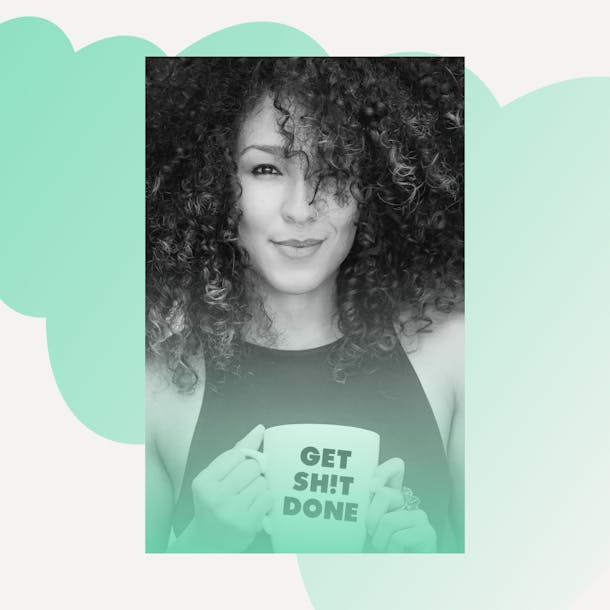
Feature Story
Sheena Allen’s plan to revolutionize banking
From small-town Mississippi to Silicon Valley and beyond, the CapWay founder is challenging our financial systems and helping more communities build generational wealth.
In case I had any question about the bold purpose behind fintech company CapWay, founder and CEO Sheena Allen spelled it out for me — on her sweatshirt — when we connected for our interview: Generational Wealth.
“That’s our big, overarching goal — our North Star,” she said. “We want to create an inclusive, holistic financial system to help individuals and families build generational wealth. It’s a challenge for Black and brown communities in the U.S., but really it’s a global problem for so many people and communities around the world.”
The data backs Sheena’s statement. Nearly half of Black households in the U.S. are unbanked or underbanked, meaning they don’t have bank accounts or don’t have access to a full range of financial services. Also, centuries of systemic inequity and discriminatory practices — lack of access to financial services and labor market and housing discrimination among them — have created barriers to Black families building generational wealth.
Given the history and current scope of the issue, there’s obviously no quick fix. Some financial services companies are making changes to become more accessible to a broader range of customers, adapting and adjusting outdated and exclusionary practices, which is a positive step. But Sheena is thinking bigger.
With CapWay, she’s determined to build a new digital banking model from the ground up that’s designed to not only help folks participate in the financial system — to transact, save, invest, and build credit in the increasingly cashless economy — but to also bridge the knowledge gap in financial literacy and achieve a healthy financial future, no matter where they’re starting from.
If you’re thinking she’s set herself a pretty massive task, you’re not wrong. Challenging the established financial system to serve people who either have no interest in the “old way of banking” (like Gen Z) or don't have a whole lot of trust in an institution that has excluded them for a long time is a big ask. Considering that Sheena is coming at this problem without a traditional finance background or banking pedigree, you might wonder just how this will all work out.
But here’s the thing: Sheena has never been intimidated by what she doesn’t know. That might, in fact, be her superpower as an entrepreneur. She sees opportunity to learn and serve where others see barriers and limitations.
“You don’t know what you don’t know”
Sheena’s hometown of Terry, Mississippi has a population of around 1,300 and only one bank — far outnumbered by the many predatory lenders (check cashing, payday lenders, and tax and title loan lenders) in the town and its vicinity. That’s not all that surprising given the prevalence of predatory lending in the state.
“Mississippi is ranked third for the number of payday lenders per capita in the U.S., and it’s also number one for unbanked and underbanked individuals per capita,” Sheena said.
Sheena didn’t think much about this banking landscape growing up. She was playing basketball, working at a local deli in the off season, and spending time with friends and her large extended family, many of whom lived in the area. It wasn’t unusual for her to go along when a family member cashed a check at the local Kroger grocery store or to hear of someone getting a title or payday loan. Some family members kept cash in their homes, and most didn’t have bank accounts.
“That was just normal as I was growing up,” she said. “My parents set my brother and I up with bank accounts in high school, which was unusual.” For most people, she said, cash was king, and long-term financial health and related benefits — building credit and investing, for instance — were either not on the radar or inaccessible.
Thinking of the experience of so many of the people she knew, Sheena paused, reflecting on a saying of her great grandmother’s. “She would always say, ‘You don’t know what you don’t know,’ and I think of that a lot in terms of what I’m trying to do with CapWay.”
Without access to financial products and services, or even the knowledge about how they can help build wealth, people can’t participate in or benefit from our financial system. They don’t know what they don’t know — and it’s preventing a lot of folks from achieving financial health and creating security for their families now and in the future.
While Sheena wasn’t aware of the impact that Terry’s financial landscape would play in her life, by the time she graduated high school, she did know that she wanted something different than the future she imagined she’d have in her small hometown.
Her first step away was to attend the University of Southern Mississippi, and it was there that a Walmart receipt would be the first step in an entrepreneurial journey that would take her much further away — and then back again.
“This wasn’t my unicorn, but it would be my greatest lesson”
As a student at Southern Miss, Sheena was determined to budget her student loan money so her family wouldn’t have to pitch in.
“I never wanted to ask my parents for help,” she said. “In my senior year, I realized I wouldn't have any more student loan money coming, and I needed to really make the most of every dollar.” That desire to track spending led to her staring down a long Walmart receipt and looking for a way to categorize expenses for her budget. To solve her own problem, she built herself an app to organize receipts and spending.
With a double major in film and psychology, a future in tech hadn’t been in the plan, but that experience changed her trajectory. “I fell in love with tech — from that first app, I knew I wanted to build a tech company,” she said.
As soon as she graduated, Sheena began pushing that plan forward. When a friend from Terry was drafted by the San Francisco 49ers, she asked if she could stay with him — she knew it was important to launch her tech career in Silicon Valley.
What she didn’t know was that the established investment networks in the Bay Area weren’t generally rolling out the welcome mat for Black female entrepreneurs. “I really wasn’t aware that I wasn’t supposed to be in Silicon Valley — I knew nothing about how few women got funding and how few Black women were in tech,” she said. “Where I grew up, nobody was talking about tech trends or startups or venture capital. I didn’t even know what to be fearful of, so I just got to work.”
Where I grew up, nobody was talking about tech trends or startups or venture capital. I didn’t even know what to be fearful of, so I just got to work.

She got to work bootstrapping Sheena Allen Apps and built a total of five apps, growing the business with enough momentum to live off the revenue and continue to feed money back into the company. She also got serious about networking: building relationships with investors and other tech founders, first in the Bay Area and then in Austin, where she ultimately moved to grow the company.
“The company was doing really well — we had over 10k downloads some days and millions of downloads total — and we did well in revenue,” she said, “but I made the decision, even as the business was growing and investors became interested, that this wasn’t going to be my home run. I knew this wasn’t my unicorn, but it would be my greatest lesson.”
She decided not to raise money and continued to put revenue back into the company and grow on her own terms, learning as she went. “I did 95% of the work — all the UI/UX design, flow charts, specs, testing, and deployment in the app store. Everything outside of back-end coding, I did myself,” Sheena said. “I don’t recommend it. It’s a lot of work, but I’m so glad I did that because I learned so much.”
She also gained a lot of insight into the startup world and what the funding process was all about, even as she opted out of the race herself. “By the time investors were interested in Sheena Allen Apps, I felt we had already passed our peak, and I didn’t want to raise. I was also aware of the benefit of running things on my own — not being responsible to investors and having more control felt good.”
“I knew both worlds”: How it all came together at Kroger
In 2016, despite all the upsides of growing her own company, Sheena found herself feeling restless. “I was honestly trying to figure out what was next for me: Was I finally going to raise money for Sheena Allen Apps? Was I going to stay in Austin or go back to California?” It was at this crossroads that Sheena found herself back in her hometown with fresh eyes.
“I went home to Terry for a visit, and when I went to Kroger and saw people still cashing their checks there, something clicked,” she said. “I had seen it all my life, but I wasn't in Mississippi very often at that point, and I had a new perspective. I realized the huge gap between what I saw there and the other places I had been living and traveling.”
What she saw now was both the immediate and long-term consequences for people who were unbanked and underbanked and didn’t have the tools to navigate the financial system, never mind build generational wealth.
“In my life beyond Terry, I became aware of how widespread the cashless economy had become — even some fast food restaurants only accepted debit or credit cards,” she said. “If you didn’t have a bank card, your choices were limited.” Beyond the inconveniences of being unbanked, many people she knew were caught in a vicious cycle of paying down exorbitant interest and fees charged by the lenders they were using in place of banking services.
That visit sparked Sheena’s ah-ha moment. She was in a unique position to create a solution. “I knew both worlds. I knew what it was like to live in a place with one bank, where people are unbanked and discriminated against, where everyone knows someone who keeps money in a mattress. But I also knew how to navigate Silicon Valley and build a tech company,” she said.
“A lightbulb went off: I thought, This is your opportunity to take what you know from one world and combine it with what you know from a different world. That was really the beginning of CapWay.”
“You’re not going to bootstrap a bank”: Raising and research
The leap from an ah-ha moment at Kroger to a fully-fledged and funded company is a big one. Though Sheena had built a successful tech company, this wasn’t like any problem she had tackled before.
“I had a vision from the beginning of really changing the financial future for what I hoped would be billions of people. I saw this being a global company and changing many lives all over the world,” she said. The name “CapWay” reflects a new way of doing capital.
With a big vision, Sheena found herself in the position of not knowing quite a lot. But she’d been there before, and she also knew the way forward was to dig in and do the work of learning.
It also meant raising capital. “With CapWay, I knew from the beginning I’d have to raise. You’re not going to bootstrap a bank. It’s just not going to happen,” Sheena said. She began to pitch to investors, several of whom she had initially connected with during her time in Silicon Valley. “I had built a network from my first startup and proven that I could build a tech company, which put me in a better position to raise for CapWay,” she said.
A successful angel round put $100K in the bank, which was enough to fund the initial research and development essential to build the business in the right way from the beginning.
She needed to know if the idea itself was even worth pursuing and if it could be a venture-backed business. She had to understand the true market size and the specific problems to be solved within that market. “I knew that the existing data didn’t fully reflect all the issues of the underbanked and unbanked; I had to understand the entire scope,” Sheena noted. To gather the research, she hit the road.
For two years, I was on planes and in my car. I went to people's homes. I talked to community leaders. I talked to different research groups. I was asking, 'What are the gaps? What do people want and need?’
As she gathered information, she found that there were piecemeal solutions for underbanked and unbanked people, like prepaid banking cards and mobile money transfer apps, but there wasn’t a full-service, digital banking solution that was accessible to everyone and didn’t rely on fees and service charges.
“I saw that what was available didn’t solve the problem, and there was still opportunity. But I knew that to serve the market that existed, we had to differentiate ourselves from the other options.” Through all her research and learning, Sheena was able to discover what CapWay’s biggest differentiator could be: trust.
Trust was a huge factor that determined whether people would engage with a financial services provider, but it wasn’t necessarily earned through interactions with a banker in a traditional setting. “I learned that the people I was meeting were much more willing to share financial information through a trusted social platform in which they were connecting with people they knew and receiving relevant content that spoke to them,” she said.
That time spent on the ground — meeting with people in person and digging into challenges, insights, and behaviors — would shape CapWay in fundamental ways. “I learned things in that research that no report or data set could have told me,” Sheena said.
Launching CapWay the right way: “This is how it needs to happen”
In 2019, after almost two years of research, Sheena and CTO Dondrey Taylor were ready with what they thought was the model for CapWay’s launch. They moved the company to Atlanta to build in a city with an established and growing network of Black entrepreneurs and investors committed to supporting founders of color.
They had planned to build CapWay as a “banking as a service” (BaaS) platform, which would mean white labeling a debit or credit card with CapWay branding but without much control behind the scenes. About six months into developing CapWay through this model, they realized it wasn’t the right path.
If they were going to build CapWay as an entirely new system, it didn’t make sense to give up majority control to an outside entity. “The whole point of building CapWay was to challenge the banking system, and we couldn't do that if we were put in a box,” Sheena said.
The founder sat down with her CTO and proposed they build an entirely new box. “Near the end of 2019, I said, ‘We’re going to build this thing out the way we want to do it. It’s going to take a lot longer, and people are going to think we’re crazy because we’re two young Black kids talking about challenging the financial system, but this is how it needs to happen.’”
That pivot led to an extended development period, which delayed their initial timeline. “I knew it would be a 12- to 18-month journey from that point,” Sheena said. “All the regulations and extra steps required in banking means fintech takes a long time if you do it the right way.”
As the pandemic emerged in 2020 and so many people were depending on digital banking and money transfers to navigate lockdown life, it became even more clear just how many people were unbanked. “When the government was distributing stimulus checks, it was eye-opening how many people didn’t have bank accounts that would allow for electronic transfer,” she said.
With a bit of extra time and lots more information, the team further built out their vision for how to differentiate CapWay, and they had complete control to build it in a way that truly reflected their mission.
CapWay today and beyond: A “holistic financial system”
In October 2021, CapWay launched — with a long waitlist — as a financial services platform that will ultimately provide an entire, holistic system of products, services, and content accessible to anyone.
Four months after that launch, when Sheena and I spoke, all of the customers on the waitlist had been onboarded and the company had exceeded many of their goals to date. The CapWay debit card and various account services are currently available and represent the start of what Sheena said is a longer list of additional products to be revealed throughout 2022 and in the years ahead.
“What we’re doing is much more than a debit card — this is a marathon to create financial access and health for everyone through a holistic system,” she said, “and we’re just getting started.”
Central to that system, and a key differentiator for CapWay, is the financial literacy content that the company provides on its site and through its app. “When I look at other digital banks, I see a lot of great features, but we believe that to be financially healthy, a person needs to be educated about how those features — financial products and services — can serve them and help them build wealth,” Sheena said.
The content that CapWay is creating looks and feels different. The videos, interactive polls, thousands of articles, and a dictionary of financial terms all reflect what Sheena learned through her research — that her target market of 18- to 35-year-olds appreciates a social approach to financial conversations and content.
“Because our model combines educational content with services, we can see if and how specific content changes a customer’s behavior,” she said. The company is building out AI capabilities to track how visitors to the site access content and how that affects their financial behavior. Tailoring their content in this way will further help CapWay understand and build trust with their customers.
“People want to do everything they can in one place, if possible, and we want to be that holistic system,” Sheena said of CapWay’s core goal. To that end, she sees significant growth ahead for her team. “We’re 17 team members now, and we’re currently hiring. I think we’ll easily be at 40-60 employees by the end of 2022,” she said.
Sheena knows her goals for the business are ambitious and that they’ll take time, but the arc of her life experiences — from Terry to Silicon Valley and beyond — have prepared her for this journey. It’s safe to say she’s in it for the long haul.
”We’re not going to build everything tomorrow or in a year or even two years, but we’re committed to creating financial access and opportunities for everyone,” Sheena said. “I want CapWay to be the place where anyone can get a fair start to financial health.”



